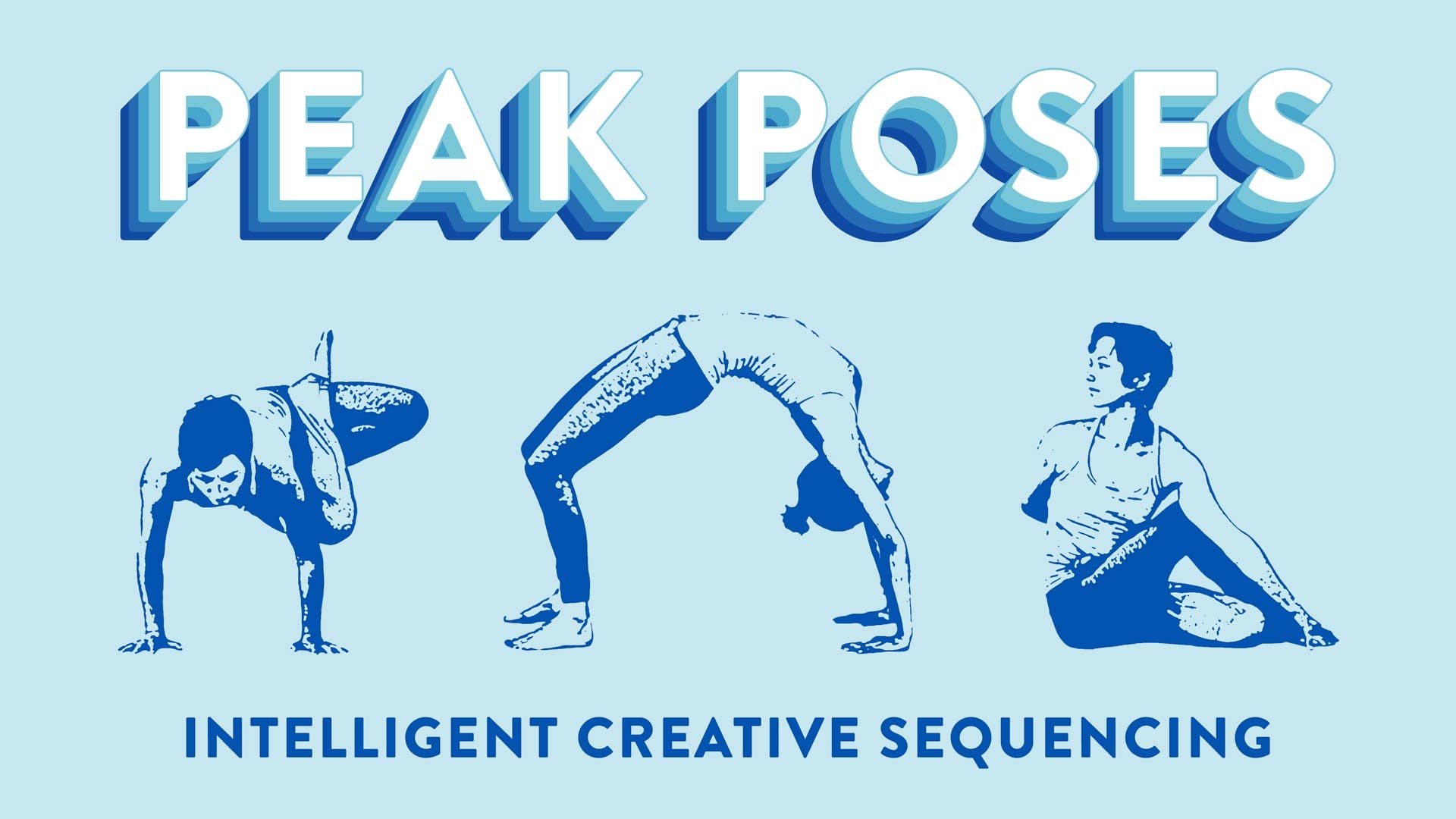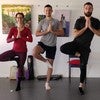Description
About This Video
Transcript
Read Full Transcript
Hi, welcome. This is a short headstand practice. We're going to practice headstand variation one and variation two. And instead of our sun salutes today, we're going to step our feet a little bit wider than our hip width's distance. And then you're just going to swing your arms.
This comes from Qigong. And you're just letting your shoulders relax and your hips swing side to side. And you really actually let your arms sort of hit your back and hit the side of your shoulders. I was once on a flight from the US to Bali. And all the women on Air China were doing this in the aisles and a lot of shaking.
It was awesome. So I've always been inspired to do this practice because of them. Good. And once you've got the juices flowing a little bit, you're going to go ahead and release that. And then take a black.
You're going to need two blacks and one blanket for this practice. And you're going to place your black next to your left foot. And take your right foot and place the pinky toe edge of your foot against the wall. And then measure with your hands. Your right hand is on the wall and your arm is straight and your left hand is reaching out.
And then make the legs strong, inhale, lift your thighs up towards your hips. And then as you exhale, shift your hips to the wall back behind you. And we're coming into Trikonasana shape. You can place your hand on the block, has multiple settings. It's fantastic.
And then take your right hand and you're going to flip your palms so that your thumbs facing away from your face and reach your hand back behind you and come to a half bind, just resting the back of your hand on your left hip. Reach out through the big toe knuckle of your left foot and then let your little chicken wing of your elbow sort of rest into your waist here. Draw the navel back and then turn the left chest up and towards the sky. But don't pull the right elbow away from your right waist. Let it rest there.
The gaze can be up or down towards the floor, however you feel, however it feels good in your neck. Good. More big breath here. And then you're going to release your right arm up into the sky. Push down into your feet, reach your right arm back and stand all the way back up.
And we'll switch sides. So step your right foot forward. Place your black right next to your right foot. Left foot, pinky toe edge of the foot is on the wall. Rest your distance so that your left arm can be straight as your right arm reaches out.
Take an inhale, lift your thighs up towards your hips and then as you exhale, let the hip shift back towards the wall. Place the hand on the block and lift your left arm up into the sky and then flip your palm as we did on the other side and let your left hand rest on your hip, taking this half bind. And again, not swinging the elbow back but letting the elbow rest forward. So you're nice and broad on the back of your heart here. Reach out through the pink, the big toe edge of your right foot.
Gently releasing the inner thigh, lengthening out through the left lung. Inhaling, exhaling, more breath, inhale. Then as you exhale, reach your left arm up into the sky. Reach it straight back behind you, push into your feet and inhale to stand all the way up. Step forward.
Place the block to the side. We'll use those in a moment. And step your right leg back to the back of the mat. Turn so that your toes are both pointing forward and make your feet nice and wide coming down for a wide legged forward fold. With hands on hips, strong belly, gentle bend of the knees is always helpful.
Bring hands down to the floor. I usually have to adjust the width of my feet here to find something that's comfortable. Bend the knees slightly, draw the knees apart from one another so you feel a broadness come to the back of your pelvis. And then walk your hands back between your feet so that your pinky, all of your toes, not just the pinky, your fingers and your toes line up in one clean line. And then straighten the legs by pushing the feet down and apart and let the gaze move forward as you lengthen from hips through the crown of your head.
Take an inhale here. And slow exhale, bend the elbows and start to place your head right between your hands. And feel this windness on the back of your heart letting your elbows move towards one another. Balance the weight on your feet and wrap the elbows so that they're not winging out but settling in as if they're sort of magnetized. Inhale fully, exhale completely.
Two more, inhale, exhale. Inhale one more time, exhale. Keep your hands where they are, inhale, push into your hands, straighten into your arms, look forward. And then exhale, walk the feet in slightly, bend the knees, bring hands to hips, breathing in come all the way up and step the feet together. You're going to grab your two blocks and place them so that they're about a footprint or footprint and a half away from the wall and they're going to be on their wide flat setting.
You're going to place your feet on the blocks. This one feels really good and it's a great way to practice and move up towards inversions by letting your head be below your heart but the back of your heart is supported on the wall. So you bow forward, place fingertips in front of the blocks, make sure feet are both pointing straight forward, center the weight on your heel joint and then walk your upper back down the wall until you feel a change in the conductive tissue in the back of your legs. When the head is supported, arms are soft, breath can move to that back of the heart. For me it's a huge calf stretch here and we'll take about five breaths together.
So inhaling, exhaling, inhaling, exhale, you might walk your heart down the wall a little bit further, breathing in, breathing out, one more, inhale, exhale, good. And then to come out, simply lift up, step off one block and then the other and then hands on hips, inhale, rise all the way up, good. So your block's to the side and we're going to come down towards seated with our fingertips back behind us and our toes out in front of us. Place your fingertips back behind your hips, your feet are out in front of you with your feet beyond the knees, you're going to lean back so that you balance more towards the bottom of your sacrum than on your sitting bones and then lift your knees up into the sky. It helps me to really glue my knees together for Navasana and then reach your arms forward.
Draw the navel back and then some of you will start to straighten into your legs and what I want you to do is not think about lifting your heart and finding a back bend here but I want you to think about letting the back of your heart rest towards your shoulder blades and instead reach through your fingertips here and then you're going to start to come down halfway keeping your head in line with your toes, stretching, it's really hard. This is Paripurna Navasana or half boat pose. Navel draws back, shoulder blades broad, take one more big breath here, inhale and then exhale, slowly place the soles of the feet on the floor, bring hands back behind you and let's grab our blankets. So the first variation of headstand that we're going to do is often, very many times, people's first inversion and this way of setting it up is really foolproof. So you're going to grab your blanket and place the knees right up to the edge of the blanket and then you're going to take your puppy paws and you're going to place your puppy paws underneath the blanket but they're nice and broad and wide like this with a little bit of like clawing action and then you place your forehead on the floor like so, very much like child's pose and then you lift your hips, elbows wrap in like we did in the Prasarita, tuck the toes and then start to lift the hips up, finding your Shashasana II set up.
So keeping the elbows wrapping towards one another like little magnets, you're going to see if maybe I call this the tiny toe dance, you can start to move your feet on the floor and feel some lightness and that's the first step towards coming up and then you'll drop down to your knees, rest for a moment, good, okay. The second step to coming up, same entrance, foreheads on the blanket, knees are right up to the blanket, what I see often with my students is that they move their knees way back and then this doesn't work. You've got your puppy paws on the floor, press into your hands, lift your hips, tuck the toes and lift the hips here. The second step to coming up, keep those elbows magnetized, shoulder blades are broad, is that you lift one heel and then the other coming to what I call the tiny ball of doom and this is very hard actually to stay here because you want to flip your feet up into the sky but you're gluing your heels towards your booty and just staying here for a moment, good, and then you'll release and come back down and rest in your child's pose once more. You can let your hands come back towards your heels and shift side to side a little bit.
Take a deep breath, so we've got the tiny toe dance, that's step one. Step two, the tiny ball of doom, everything's tiny. And then step three is beginning to lift the legs up into the sky coming to the full tripod headstand variation. So again, foreheads on the blanket, puppy paws are underneath, lift the hips, tuck the toes, come on up and then one heel to your seat, the other heel to your seat and then this time maybe starting to lift the heels up into the sky. Magnetizing those elbows, bed.
To come out, reach through the toes, bring one leg down and then the other. Place the knees on the floor, let your head rest, let hands come back behind the heels. You've got one more entrance for Sureshasana 2 today before we move on. So set yourself up again, hands come underneath the blanket, good rest people. You can do it, stay with it, lift the hips, tuck the toes, magnetize the elbows.
This is if all has gone well. You've got those long hamstrings from the forward folds. You're going to start to lift both toes off the floor at the same time gluing the inner edges of the feet together and coming all the way up to Sureshasana 2 tripod headstand. Good. Wrapping the shoulder blades, big triangle shape between head and arms and then you'll come all the way down.
I like to see if I can come down to the tops of my feet and then drop my knees and then sit my head back, my hips back and release my hands and relax. Good. Bring hands out by your shoulders, take them nice and wide, come to fingertips, lift your chin, push your hands down into the floor and start to come up. Great. Let's set the blanket aside.
Take your two blocks and place them so that they're smooching one another like this and then make headstand shape with your hands but make it so that you're not doing a death grip like this but rather opening the hands up and tucking your pinky finger underneath and then place your forearms on the floor but not your wrists. So the wrists are off but your elbows and your forearms are on the blocks and then you're going to walk your knees back a little bit, push your forearms down into the floor and then slowly shift forward and back, forward and back and when you're doing this you do not want to sink the chest towards the floor, you want to keep the chest nice and lifted the back of the heart moving towards the sky just as you did when you were against the wall in that forward fold. Do a couple more. Shoulder blades moving apart from one another, side chest engaging, great and then release that. Okay, let's set our blocks to the side once more.
And then we're going to come towards headstand using this clasp. So there's a couple things to remember, there's three main things to remember here is that you want to separate the hands so that you've got a basket rather than the death grip tucking the bottom pinky finger in and this allows for our head to be able to rest neatly in our hands. The second thing is that we want to remember to push into our whole forearms when we're starting to learn to come up so not just the elbows but the whole arm even the pinky finger edge of the hands. And then the third thing is that for many students I see them start with the elbows really wide on the floor like this but we want to actually make it narrow. So come on down, place your elbows on the floor, have them inner shoulder width distance apart and then pull them apart so that your skin catches on the mat and kind of gets this like traction feeling happening.
And then go ahead and tug your chin and place your head, top of the head on the floor so that you've got that nice cupping of the hands. And then it's the same actions as the tripod headstand variation. You tuck the toes, lift the hips, keep pushing and then you have the tiny toe dance. And then you have the tiny ball of doom. And then you have coming all the way up, pushing, pushing, pushing, coming all the way to your headstand to come out.
If you push, there's not going to be a lot of weight on your head but as you come out some people stop pushing so you want to keep the pushing really, really, really, really constant and you can come down one leg and then the other leg. And rest again in your child's pose with your forehead on the floor. And then bring your hands out by your sides. Fingertips are going to be shoulder height distance but nice and wide coming to fingertips. And then draw your shoulder blades onto your back, look up to reestablish a cervical curve in your spine.
Push your fingertips down and come all the way up. Good. Okay. So to rest, we're going to come and sit for a little bit and just like sort of sit in the sauce from our headstand practice. Come to a comfortable cross-legged seat.
Let your hands rest on your thighs. Let your shoulders drop down away from your ears and gently draw the chin in towards the front of your throat to lengthen through the back of your neck. Let the breath become just soft and gentle, not controlled or using Ujjayi. I'm just pausing here for a couple of moments to finish practice. Eyes can be soft or eyes closed.
And gently lifting your hands to your heart, letting your head bow in. Bring a big bow down to that seat of expansive love that resides within each of your hearts. Namaste.
Peak Poses: Audra Carmine
Comments
You need to be a subscriber to post a comment.
Please Log In or Create an Account to start your free trial.










